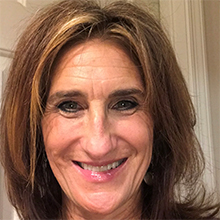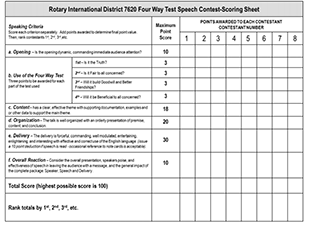
Temrah Okonski
By Temrah Okonski, assistant governor in District 7620 (D.C. & Maryland, USA)
Our district faced a critical decision on what to do about our annual speech contest on The Four-Way Test when the COVID-19 pandemic began to change the world last year. We decided to still hold one, but online. The results proved to be way better than we expected. And we’re convinced that with these few pointers, you can hold your own virtual competition.
Step 1: finding students
The first challenge we faced was reaching students who were in school but functioning under COVID-19 restrictions. Your club may have a contact willing to advertise the competition through in school-on-line newsletters. Or you may also want to set up a meeting to inform students about the competition. But these will most likely need to be virtual, after school hours, and arranged by and attended by a school staff member.
Your contest committee members will want to reach out to your District’s RYLA and Interact Committee chairs to advertise the competition, and have your executive secretary, if you have one, ask members to reach out to their local high schools to advertise the event. Using these different channels, our district was able to double the number of student applications, from 12 in 2018 to 26 in 2019. Our committee was also tasked with matching students to a sponsoring club if they did not have one.
Step 2: preparing students for the competition

District 7620 set up a website to help clubs, judges, mentors and students with their virtual speech contest on The Four-Way Test, including resources like this scoring sheet.
Our committee made sure that students with no local school support were paired with Rotarians and Rotaractors willing to vet topics, proof speeches, and coach them on their presentation. Mentoring took place virtually. Our district public images chair also created a web page with resources for students, mentors, and judges including two videos, linking to the scoring sheet, videos of past winners, and a tip sheet of basic requirements.
Step 3: Judging contestants virtually
We asked students to record their speeches at home and upload them to YouTube. We then downloaded them onto our landing page. Committee members organized three rounds of judging. The first round watched the speeches and identified their top 12 candidates, while the second set of judges narrowed it down to four. The top four students then were invited to compete in a final round held live on the GoToWebinar online platform during our district conference. Conference attendees voted online for their favorite speeches. Scores were tallied during a break, with the winners announced to smiles and cheers.
Lessons and final takeaway
It took hard work and a lot of adjustments to pull it off, but our leadership was 100 percent behind us. There were questions and concerns along the way. Some clubs that had sponsored many contestants in the past felt slighted by the new process. Others felt the online judging would not capture the excitement of live competition. We weren’t sure our conference technical setup would remain stable for the final presentations. But based on evaluations we sent out, people felt it was a huge success.
This new, virtual format encouraged a wider diversity of students to participate. It also provided more opportunity for Rotarians and Rotaractors to mentor the contestants and serve as judges. Because of this, we plan to blend our traditional “in person” competition, as soon as conditions safely allow it, with the new virtual format. Contact me at okonskitg@verizon.net to learn more about how we organized and executed our virtual speech contest on The Four-Way Test.
https://blog.rotary.org/2021/01/29/how-we-held-our-speech-contest-on-the-four-way-test-online/
